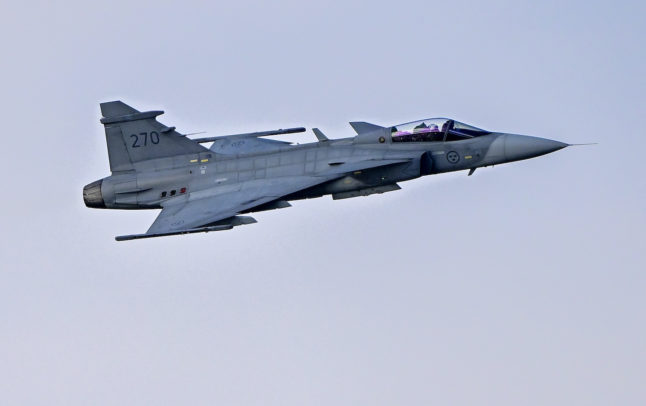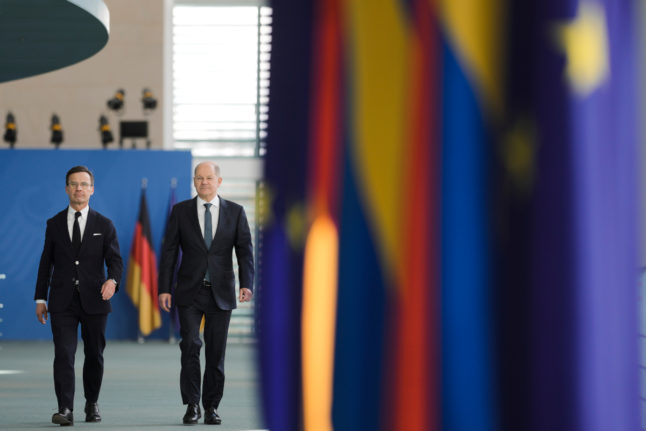The need for Sweden’s jets
Earlier this month Volodymyr Zelensky said that, after tanks, fighter planes are “the next level of our cooperation.”
Some commentators have said that Sweden’s own fighters are the best option, since they are tougher and easier to operate than other western jets.
Two proponents of sending Swedish fighters to Ukraine include British MP Bob Seely and analyst Justin Bronk from the Royal United Services Institute (RUSI), who both argued that Swedish JAS Gripen fighter jets would be better than British Typhoon jets, citing factors such as how they can use shorter runways, even landing on roads in some cases, can fly low, and need smaller crews and support staff.
“It would be better to work with our Swedish friends to offer the Saab Gripen, a fighter jet that can be operated by a pilot and one trained crew member, as well as a small ground support team,” Seely wrote in the UK’s Daily Mail earlier this month.
‘Developed with Russia in mind’
But just how suitable are the Gripen jets for defending Ukraine?
An air power expert at Sweden’s Defence University, Arash Heydarian Pashakhanlou, agreed that the Gripen is simple to maintain and only needs a few people to be refuelled and armed with advanced missiles, and that it can use short runways. The jets can also be dispersed out over a wider area to make them less vulnerable to attacks, he told The Local.
He added that the Gripen is “developed with Russia in mind and is therefore very suitable for the situation that Ukraine finds itself in today”.
Martin Lundmark, an expert in defence systems at the Defence University, said the Gripen is “unique” in this respect.
“All other modern fighter jets need longer runways for take-off and landing, and need more staff for the turn-around.” He added that the Gripens can be made ready to fly again significantly faster than other modern jets can.
But he warned that British enthusiasm for the Gripen’s ability to land on “rough runways” could be exaggerated.
“It depends on how rough, and there can’t be potholes. Then the risk of a puncture or other damage to the plane would be too great.”
The big difference, Lundmark told The Local, is that other modern jet fighter planes need smooth cement for their runways, while the Gripen can handle normal straight asphalt, as found on roads.
Decision lies with the government
The maker of the Gripen, Saab AB, confirmed that their jets are simple to fly, can start and land from dispersed bases and are simple to maintain, when The Local contacted them for comment.
Saab’s head of press Mattias Rådström wrote, however, that any interest from Ukraine in buying Gripen jets are best put to “the responsible authorities”, rather than Saab, adding that the Swedish government would ultimately be responsible for deciding to sell or not.
The independence of the Swedish arms industry could, in theory, make this decision easier.
Britain’s Typhoon Eurofighter, for example, could only be sent with the consent of the other countries involved in the Eurofighter programme, namely Germany, Italy and Spain.
Likewise, countries in Europe that operate American-made F-16 and F-35 jets can only send them with the consent of the US government.
Sweden’s fighter programme however, designed to withstand Soviet attack during the Cold War, is under the control of only the Swedish government, meaning that Sweden is free to send Gripen jets to Ukraine if it deems fit.
Kristersson reluctant to go it alone
Last week, Swedish prime minister Ulf Kristersson said he’s not ruling out any decision on Gripens for Ukraine, but that such a decision would be taken together with Sweden’s allies, even if in theory Sweden and its government has full control over the Gripens.
Martin Lundmark, at Sweden’s Defence University, pointed out some practical issues that may pose the biggest barrier to Ukraine getting the current version of the Gripen, the model C/D.
“It would be possible, as I see it, to deliver jets fast, that is to say in a matter of months. However this would require Ukrainian pilots to be trained. The Gripen C/D is a much more modern plane than the Soviet MiG and Sukhoi planes that Ukraine has now.”
Although the Gripen jets are more simple to run than other similar jets, they would still require considerable training before they could be used, Lundmark told The Local.
“Pilot training normally takes several years. There would also be a need for facilities close to Ukraine for tasks such as maintenance, refuelling, equipping and supplying spare parts.”
In addition, Lundmark added that Sweden doesn’t have any surplus of the plane, and they are all currently in use, so any transfer would reduce the number of planes that Sweden has available to defend its own skies. Swedish pilots would also need to stay in Ukraine for some time to train Ukrainian pilots to fly the Gripen jets.
Make or break time for the Gripen?
Other factors could mean that the existence of the Gripen plane itself is under threat.
British MP Bob Seely wrote in his article that, regarding the Gripen, “Saab wants to sell and Ukraine wants to buy”.
But Saab has recently had trouble finding foreign buyers for the plane.
Responding to the decision by Finland and Canada to buy American F-35 instead of Gripen-E jets last year, Saab’s CEO Micael Johansson told technology magazine Ny Teknik that “it is a tough market, which deals a lot with security policy and political decisions”.
“The USA is a strong player, and it is a lot about how countries want to ally themselves.”
Currently only Sweden and Brazil have bought the Gripen-E.
Both Sweden’s Supreme Commander of the Armed Forces, Micael Bydén, and business newspaper Dagens industri have raised the idea of an “unconditional investigation” into whether Sweden should stick with the Gripen, or turn to alternatives including American fighter jets, as its Nordic neighbours have done.
This all means that while the Gripen is definitely suited to the conditions that Ukraine is fighting in right now, there are political and practical issues that are slowing down any chances of Gripens being transferred, and in the longer term, after years of pilot training, the plane might even not be in production any more.



 Please whitelist us to continue reading.
Please whitelist us to continue reading.
Member comments